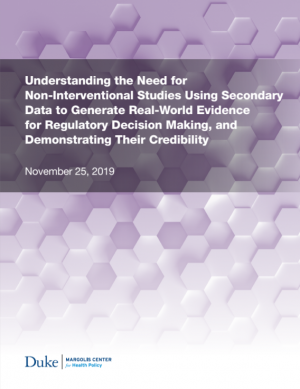
White Paper
Understanding the Need for Non-Interventional Studies Using Secondary Data to Generate Real-World Evidence for Regulatory Decision Making, and Demonstrating Their Credibility
Randomized, blinded, and controlled trials are the gold standard for establishing product effectiveness. However, stakeholders throughout the health care environment (i.e., sponsors, regulators, payers, providers, and patients) are eager to leverage real-world data (RWD) and real-world evidence (RWE) in their decision making. Essential to advancing RWE in health care decision making related to medical product effectiveness is evaluating its quality and credibility. While stakeholders desire the inclusion of randomized controlled trial (RCT) characteristics (i.e., randomization, blinding, and controlling) in the design of real-world clinical studies for evaluating treatment effects, many of the challenges to conducting RCTs are also applicable to interventional studies in the real world. Furthermore, due to significant advancements in both generating fit-for-use RWD and developing robust analysis methods, other types of real-world study designs, including non-interventional study designs, may also be able to support valid causal inference.
This paper explores the feasibility challenges to conducting interventional studies in the real world to provide guideposts for when non-interventional studies could inform regulatory decisions related to effectiveness. Specifically, ethical, operational, and resource barriers that may hinder the ability to randomize, blind, and control are discussed. The paper then highlights key considerations for how to demonstrate the credibility of a non-interventional study using secondary data that is intended to support an evidence package submitted for regulatory decision making. This includes a discussion of various methods for non-interventional studies using secondary data, the biases they intend to address, and how they can be mapped to the characteristics of an adequate and well-controlled study as outlined in the Code of Federal Regulations.
While there are different types of real-world study designs, this paper focuses on non-interventional studies using secondary data because their potential application in support of regulatory decisions regarding effectiveness is not as well characterized as interventional RWE approaches that include randomization (e.g., pragmatic or large simple trials) or hybrid designs that utilize RWD as an external control. Non-interventional studies using secondary data can better reflect the broader patient populations, settings, and drug uses that are typical of clinical practice and, in some cases, can be conducted more efficiently than traditional RCTs. These studies should be viewed as a complementary source of evidence to RCTs that add unique and valuable information regarding the performance of medical products.
